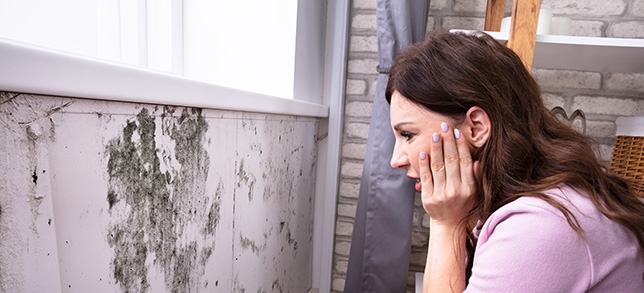What are the health effects and symptoms caused by mould in your home?
Table of Contents
● The causes of the discomfort or sickness may be mould in your house
● What effect does mould have on your family’s health?
○ Mould toxicity
○ Mould affects not only physical but also mental health
○ Infections
○ Asthma
○ Pneumonitis
○ Aspergillosis
○ Allergic reactions
○ Nausea
○ Dizziness
○ Other complications
● Keep the living environment comfortable; control moisture/dampness
● How nanoe™ X technology in your house can remove mould to protect your health
Mould is a common occurrence in homes across the world.
A certain type of fungi that tends to grow in dark, damp spaces, mould is a troublesome issue to deal with. Whilst it’s an unpleasant sight to see, the issues surrounding mould go further than the aesthetic.
In fact, mould can actually cause or contribute to a number of health issues. But what exactly are these issues and what are the symptoms? Let’s take a look at the negative health effects and symptoms caused by mould in your home.
The causes of the discomfort or sickness may be mould in your house
Countless homes across the world suffer with some form of mould.
Mould typically exists on various plant and animal matter, and when it comes to our homes it typically exists on materials such as plasterboard, wood, carpets, curtains, and even our clothes. And once mould has settled, it can easily grow and start to spread.
That makes your home a potential hotbed for various types of mould.

Mould will only grow when there is enough moisture present. That can either be moisture on a surface or humidity in the air. Common causes of mould in your home include:
● Leaky plumbing
● Hot and humid environments
● Blocked pipes or gutters
● Leaky roofs or walls
● Uninsulated windows
● Condensation from cooking, drying clothes, or showering
● Organic substances that nourish molds
When left unchecked, a buildup of mould in your house can cause a variety of health problems. Let’s examine these in more detail.
What effect does mould have
on your family's health?
Mould toxicity
Mould toxicity is a type of chronic illness that can come from prolonged exposure to mould. Commonly unrecognised, mould toxicity can cause gut dysfunction, fatigue, unexplained anxiety, and a loss of cognitive function. When you are exposed to this poison, it can cause issues with your immune system and is also known to be toxic to your skin, liver, kidneys, gut, and nerves.
One of the tricky things about mould toxicity is that you do not have to have visible signs of mould in your house to suffer from it. But it’s far more prevalent when your house has clear black mould symptoms which often occur when extreme moisture is present, such as when a house has experienced flooding.
Mould affects not only physical but also mental health
Somewhat surprisingly, the health effects of mould in your house are not just physical. Since mould causes a wide variety of negative health implications, this in turn can cause a negative impact onyour mental health.
Mould symptoms
When you inhale mould spores or airborne mould fragments, it can inflame your airways. This in turn can cause a number of further issues. The physical symptoms of mould in your home include:
● Wheezing
● Tightness in the chest
● Nasal congestion
● Coughing
● Throat irritation
● Weight loss
● A raised temperature
Let’s take a look at some of the conditions that regular exposure to mould in your home can cause:
Infections
When you are in an environment that has a high level of mould, you can increase the chances of infection from breathing in mould spores. The most common type of infection tends to be in your lungs – this includes infections such as:
● Histoplasmosis
● Sporotrichosis
● Coccidioidomycosis
Asthma
Reactions can occur when you breathe in small mould particles in the air. These spores can worsen the symptoms of asthma, or even reduce your lung function and cause asthma to develop

Pneumonitis
When you are exposed to a large amount of mould, you can experience a more complex reaction which is known as mould-induced hypersensitivity pneumonitis. This is a macrophage- and lymphocyte-driven type of inflammation which is commonly caused by contaminated humidifiers or heating-ventilation systems.
Aspergillosis
Aspergillosis is a respiratory condition that is caused by inhaling small particles of aspergillus mould.
This type of mould is most commonly found in dust, damp buildings, air-conditioning systems, and damp plant matter.

Allergic reactions
It is possible to be allergic to mould. If you have a mould allergy, your immune system can overreact when you breathe in mould spores, which can lead to a number of different issues. These symptoms can be countered by medication, although the best method is to reduce your exposure to the types of mould that cause a reaction.
Nausea
Mould particles contain toxins known as mycotoxins. These toxic compounds are naturally produced by certain types of fungi and in small quantities can cause nausea, vomiting, diarrhoea, and other similar symptoms.

Dizziness
The mycotoxin compounds contained within mould particles can also affect the central nervous system.
This can lead to headaches, dizziness, memory loss, and other neurological issues.
Other complications
The health effects of mould in your home are well documented. However, it is also worth mentioning that mould can also be distressing to have in your environment for other reasons.
The symptoms of living in a mouldy house are not purely physical, but also aesthetic. If you are living in a house that has a number of mould patches, it can make what is supposed to be a safe space a very unpleasant place to live in – which can take a further toll on your mental health.
Keep the living environment comfortable; control moisture/dampness
Many people will have experienced some form of issue with mould in their homes at various points in their lives – as even well-looked-after properties in warm climates can experience mould growth. This growth will predominantly be down to dampness or condensation.
The most common causes of this dampness and condensation in your home are:
● A lack of adequate ventilation and/or heating
● High levels of moisture vapour
● Water leaks due to damaged pipes or uninsulated windows
● High levels of rising damp originating from the ground
> How to get rid of mould in every corner of your house
That is why it is imperative that you keep your living environment comfortable by controlling the moisture and dampness in your home. But this is far easier said than done.
How nanoe™ X technology in your house can remove mould to protect your health
Once mould settles into your home, it can be difficult to get rid of.
nanoe™ X works by reaching mould particles and denaturing the mould proteins in the eight major varieties of household mould¹ with highly oxidized hydroxyl radicals – thereby inhibiting the further growth of mould within your home.²
nanoe™ X can not only reach and inhibit airborne mould, but is even effective against adhered mould that is commonly found indoors. So whilst it is not possible to remove mould once it’s occurred nor prevent symptoms caused by mould, nanoe™ X can quickly break down existing mould particles and stop them from further spreading.
Allowing you to breathe cleanly, safely, and comfortably.








